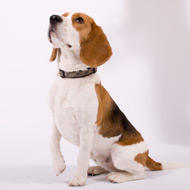
Texan professor discovers a pig pheromone that can stop dogs from barking and jumping
A professor at Texas Tech University has discovered that androstenone, a pheromone secreted by male pigs, can help curb bad behaviour in dogs.
Professor John McGlone, who studies animal behaviour, happened to have a product at home called Boar Mate - which is used by farmers to help their swines breed. It is foul-smelling to humans and also affects dogs through their sense of smell.
Androstenone is produced by pigs in their saliva or fat, but the androstenone in Boar Mate is manufactured in a laboratory. Prof. McGlone gave one spritz to his dog Toto, and immediately the dog's constant barking stopped.
After the discovery, the professor contacted a canine research site with a wide range of adult dogs of different breeds. In addition, 50 per cent of the dogs there barked incesssantly, making it perfect for testing Prof. McGlone's theory.
Prof. McGlone and his team tested the product on four different groups of barking dogs in separate kennels.
The first group of dogs had a person with another dog stand in front of the kennels. The second group of dogs were sprayed with a placebo that made a startling, spritz noise. The third group were sprayed with the noise and a lower concentration of androstenone in isopropyl alcohol. The fourth group was also sprayed with the noise and a higher concentration of androstenone in isopropyl alcohol.
In the first group, 25 per cent (3 out of 12 dogs) stopped barking. In the second group, 44 per cent (4 of 9 dogs) stopped barking. In the third group, sprayed with the lower concentration of the pheromone, 78 per cent (7 of 9 dogs) stopped barking. In the fourth group, sprayed with the higher concentration of androstenone, 100 per cent (6 of 6 dogs) stopped barking.
After proving its effectiveness, Prof. McGlone was able to classify androstenone not only as a intermone as well as a pheromone. Intermone being a term he developed that refers to a product that is "a pheromone in one species and has a behavioral effect in another species, but we do not know if it is a pheromone (naturally produced) in the other species.”
Despite its effectiveness in curbing bad behaviour, Prof. McGlone warns that the pheremone is not a complete cure for barking as the effects only last around one minute. He is now experimenting with other pheromones, such as those from dogs, cats, pigs and horses, to see if they have the same effect.



 The RCVS has announced a new version of its 1CPD mobile app, with enhanced features for veterinary surgeons and veterinary nurses to record their continuing professional development.
The RCVS has announced a new version of its 1CPD mobile app, with enhanced features for veterinary surgeons and veterinary nurses to record their continuing professional development.